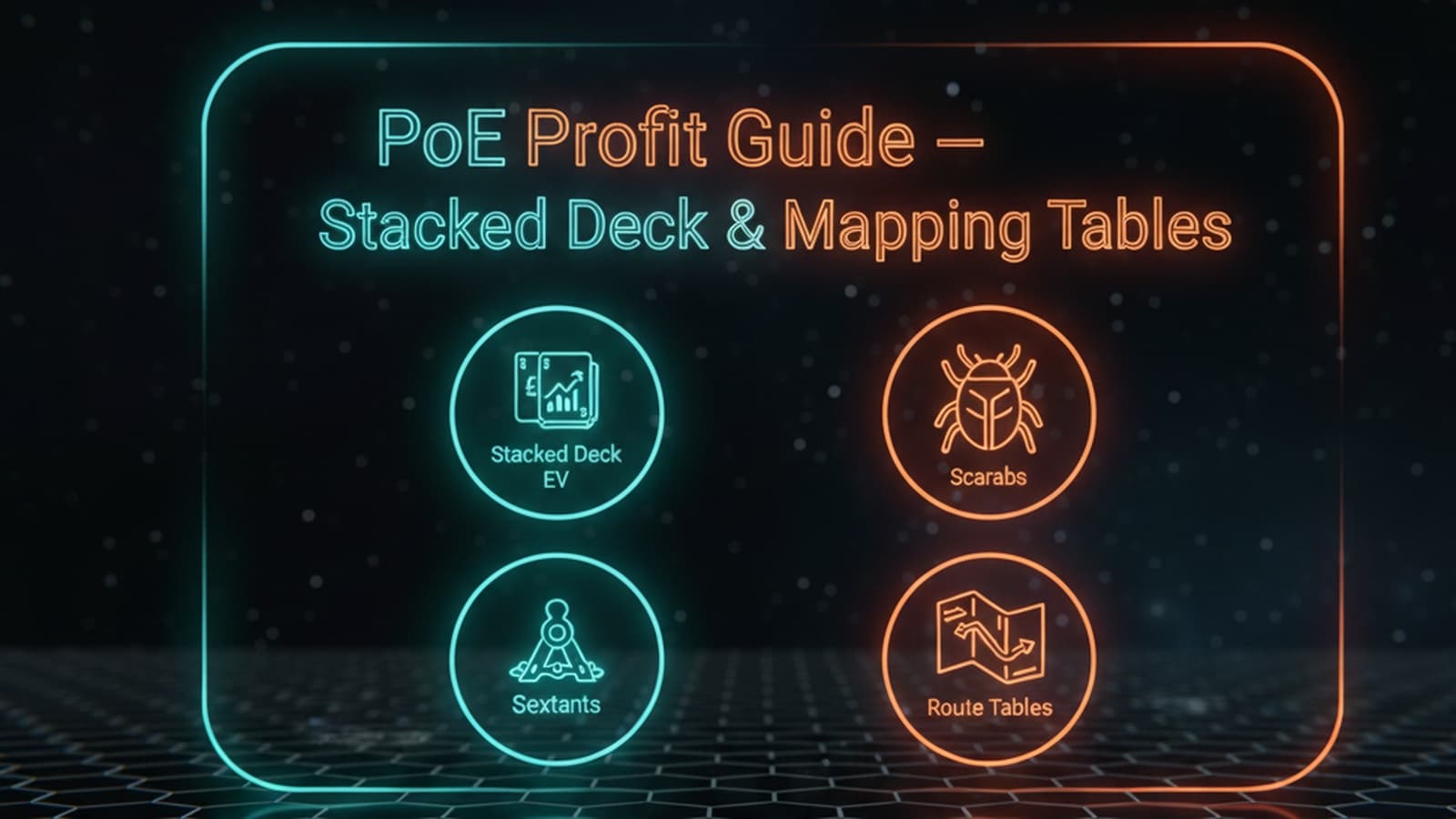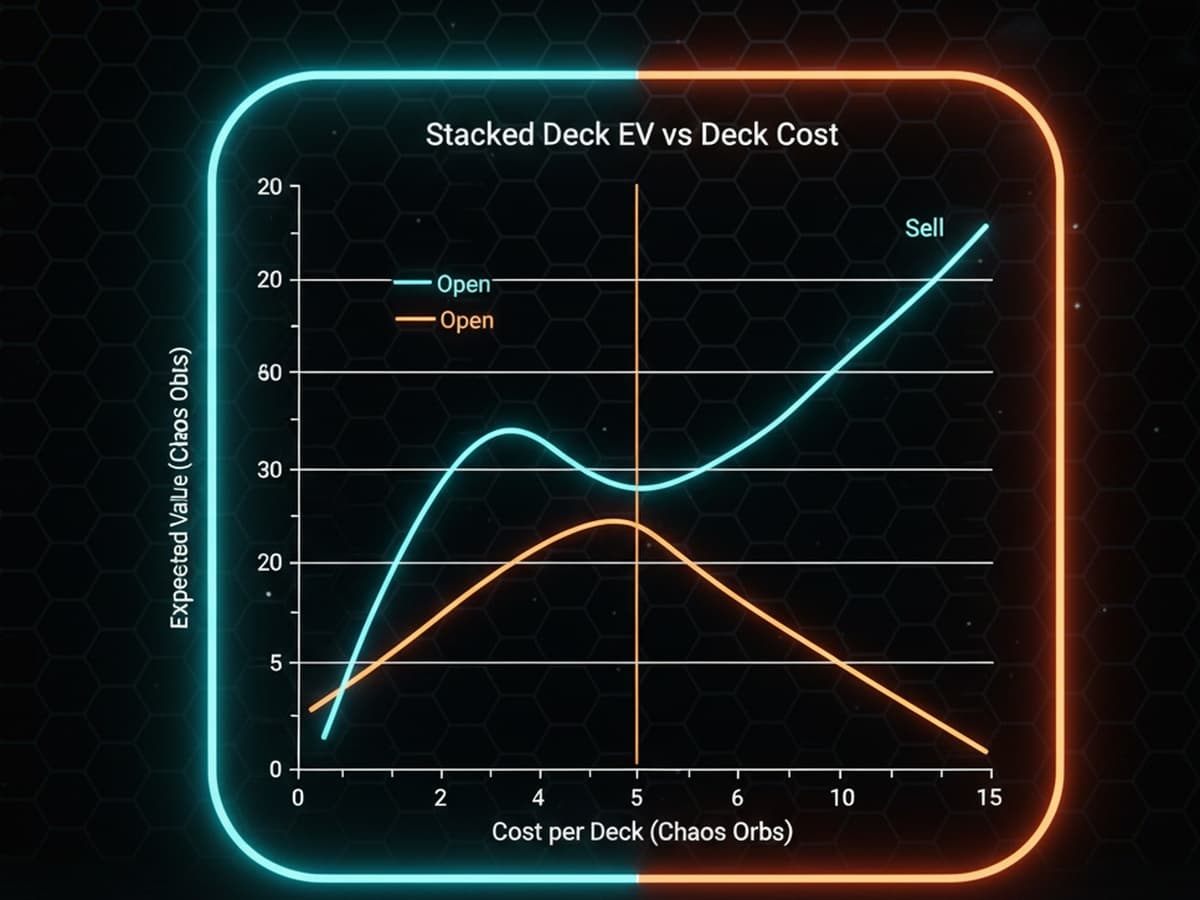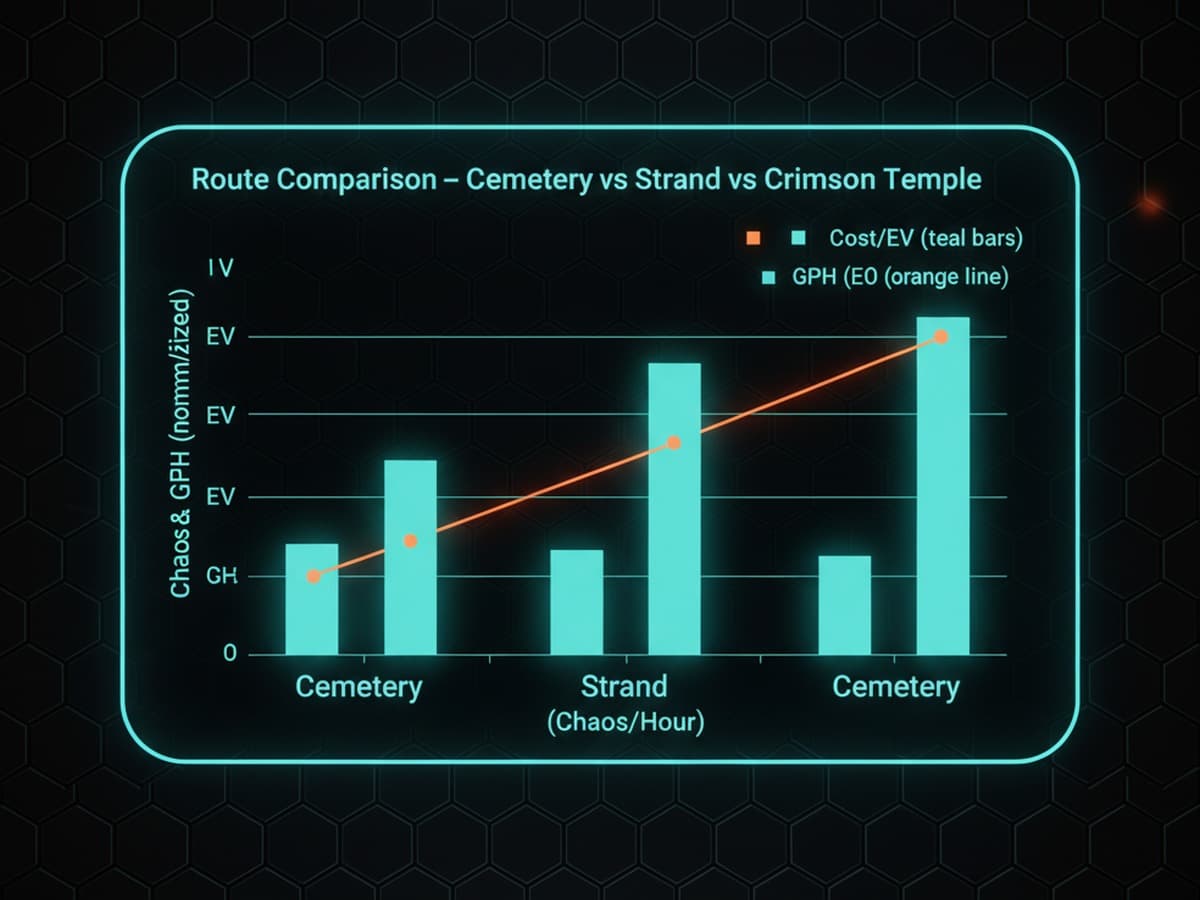
Path of Exile Profit Guide: Stacked Deck EV, Mapping Routes & Tables
By LootCalc Team · Published on 2025-10-17
This comprehensive Path of Exile profit guide brings together Stacked Deck expected value (EV), a practical PoE mapping profit model, and easy-to-scan route comparison tables to help you maximize your currency farming efficiency. Whether you're farming for your first Mirror of Kalandra or optimizing divines per hour to fund your next build upgrade, understanding the interplay between investment costs and actual returns is crucial for success in Path of Exile's competitive economy.
Our goal is to help you decide when to chase deck EV, when to juice maps, and how to trade time-for-value without falling into the classic trap: EV per action rises while currency per hour (GPH) falls. Many players optimize for the wrong metrics—maximizing value per map while their hourly income stagnates or even declines. This guide addresses that disconnect with concrete strategies, real numbers, and actionable frameworks you can implement immediately. If you need quick definitions, open our Glossary (see variance, quantile, confidence interval). For calculators tailored to PoE farming strategies, start at the Path of Exile Tools Hub.
Path of Exile Stacked Deck Drop Rates & Expected Value (EV)
Stacked Decks are a staple because they compress divination-card variance into consumables that you can open or sell. The market EV of a deck changes with card prices, league mechanics, and supply shocks. In this section we model the EV as price-weighted sums less your acquisition cost. Use price snapshots; then update your sheet weekly.
Understanding Divination Card Economics in Path of Exile
The Path of Exile currency market operates on supply and demand dynamics that shift with every league mechanic change. Stacked Decks represent a unique investment vehicle where understanding market timing can mean the difference between profitable farming and wasting hours. The key is tracking not just individual card prices, but the entire ecosystem of divination cards that can drop from your decks.
Price snapshots & sensitivity to market moves
Deck EV is driven by a few heavy hitters plus a long tail. When a chase card's price halves, the total EV can drop far more than newcomers expect. We recommend tracking: (1) a Top-10 weighted basket, (2) a median card basket, and (3) a simple sell-now vs open threshold. If the sell price is within 5–8% of modeled EV, consider selling decks for consistency. For more on understanding variance in loot outcomes, check our drop rate math guide.
Quick EV formula for Stacked Decks
EV(deck) ≈ Σ [ P(cardᵢ) × Price(cardᵢ) ] − Cost(deck)
Inputs & assumptions
- Prices are market snapshots; update with each patch or meta shift.
- Opening time counts: add 0.5–1.0s per deck to your loop pace.
- Account for bulk-sell friction (fees, whispers, trade time).
When to reset prices
Reset after major events (league start, mid-league balance, atlas rebalance). If your observed sell-through deviates >10% from the model, refresh.

PoE Mapping Profit Model: Costs, Scarabs, Sextants & Atlas Tree
The mapping model estimates profit per hour (GPH) by combining map cost, juice multipliers, and loot density. Don't let EV/card distract you from loop time. If your travel and prepare phases balloon, GPH tanks even when EV per map climbs. You can reproduce the math in a spreadsheet or adapt the approach inside the PoE currency calculator.
Atlas Passive Tree Optimization for Currency Farming
Your Atlas passive tree is the foundation of any mapping profit strategy. Each passive point should directly contribute to either increasing loot density or reducing time per map. Popular nodes for currency farming include Divination card chance, pack size increases, and league mechanic frequency bonuses. The best PoE farming strategies balance these passives with your build's strengths—don't force a slow build into speed content or vice versa.
EV vs GPH in mapping: travel time & pack size
Juice raises EV per map but increases time per map. The sweet spot depends on your clear speed, Atlas Tree, and party synergy. For high-density strat, ensure you're not over-capping defenses or wasting damage—dead time is the silent leak. Understanding the relationship between expected value and gold per hour is crucial—read our comprehensive EV vs GPH guide for deeper analysis.
Time cost per loop & map pacing
- Map open & portal walk: 10–20s per loop.
- Clear time: 60–120s depending on strat and build.
- Looting & stash cycling: 15–45s, spikes with heavy juice.
Risk & variance, dry-streak expectation
Heavily juiced maps introduce long dry streaks punctuated by jackpots. Plan your bankroll so a bad 30–60 minute window doesn't force you to de-juice. If you need a refresher on variance and confidence, read Variance, Dry Streaks & Confidence in Drops.

Route Comparison Tables: Cemetery, Strand, Crimson Temple
Below we "table-ize" popular routes so you can weigh route / cost / yield at a glance. Numbers are example snapshots—override with your market to keep the comparisons honest.
| Route (Atlas) | Map Cost | Scarabs | Sextants | Time/Map | EV/Map | GPH |
|---|---|---|---|---|---|---|
| Cemetery (Deck focus) | 8c | 20c | 12c | 2m 10s | 65c | ~1.6–1.8d/h |
| Strand (Speed chain) | 6c | 10c | 8c | 1m 30s | 42c | ~1.7–1.9d/h |
| Crimson Temple (Div cards) | 10c | 28c | 14c | 2m 40s | 78c | ~1.5–1.7d/h |
Budget tiers: low, mid, hyper-juice
- Low: Rusted scarabs, minimal sextants; sustain via map returns.
- Mid: Polished/Gilded scarabs; compasses on beyond/legion.
- Hyper-juice: Full compasses, deli orbs if meta supports the map.
Deck farming playstyles
Deck focus benefits Cemetery / Crimson, but Strand's pace beats variance for many players. Pick what you can maintain for hours—fatigue erases theoretical EV.
Inputs & assumptions (costs, juice, favors)
Costs assume bulk-buy rates and average atlas passive allocation. If you re-spec into expedition, legion, or harvest, adjust the juice and time rows first.
When to switch route
Switch when your time/map crosses a breakpoint (e.g., 30s longer) and you cannot offset it with higher EV/map. Otherwise, you're trading comfort for lost GPH.

Practical Checklist for Currency Farming Efficiency
- Lock a loop time target (e.g., 90–120s) before adding juice.
- Track maps/hour and loot per map, not feelings.
- Snapshot prices weekly; re-calc EV and switch routes if needed.
- Measure stash friction: looting habits often cost more than sextants.
- Use party synergy for compasses; solo requests should fit your build's speed.
Advanced Profit Optimization Strategies for Path of Exile Mapping
Beyond basic route selection and juice investment, advanced players optimize every aspect of their farming loops. These strategies require initial setup but pay dividends over hundreds of maps.
Bulk Trading & Market Timing for Maximum Returns
Bulk trading scarabs, compasses, and maps at the right time can increase your effective GPH by 15–25%. Buy your juice during peak supply periods (weekends, league starts) and sell valuable drops during scarcity windows. Monitor the currency exchange rates daily to identify arbitrage opportunities. Setting up buy orders while you sleep ensures you never pay retail for consumables.
Build Selection Impact on Currency per Hour
Your build choice matters more than most players realize. A 200 Divine build that clears 15% faster than a 50 Divine build will pay for itself in under 100 hours of mapping. Prioritize movement speed, screen-wide clear, and survivability that prevents deaths. Each death costs 30–90 seconds of pure downtime—avoiding just two deaths per hour adds 10+ maps to your daily output.
Loot Filter Customization for Efficiency
A well-tuned loot filter is invisible profit optimization. Hide everything below 2 Chaos value unless it's compact (like currency or scarabs). Show divination cards, valuable bases, and high-tier currency with distinctive sounds. Review your filter monthly as the economy shifts—what was valuable in week one becomes vendor trash by week eight. The best loot optimization strategies treat filter management as seriously as build optimization.
Multi-Account Stash Management
Top farmers use dedicated dump tabs and automated sorting systems. Spend 30 seconds per map on loot management maximum—anything more and you're bleeding efficiency. Price everything in bulk tabs at slightly below market to ensure quick sales, then reinvest immediately into more juice.
Tracking Performance: Data-Driven Farming
What gets measured gets improved. Track maps per hour, raw currency drops, and total liquid value per session. Use spreadsheets or PoE calculators to identify which routes actually work for your playstyle. Many strategies look great on paper but fail in practice due to personal preferences or build limitations. Your data over 100+ maps is more valuable than any guide.
Common Profit Leaks & How to Plug Them
The biggest profit leaks aren't obvious: excessive trading breaks, inconsistent juice application, running out of maps mid-session, and poor scarab choices. Each trade whisper costs 15–45 seconds. Batch your sales and use TFT or bulk buyers. Running out of maps forces a 5–10 minute restocking break—maintain 50+ map reserves. Bad scarab choices (using Ambush on non-juiced maps, for example) waste 15–20c per map for minimal returns.
FAQ: PoE Profit, Stacked Deck Price & Magic Find
Is selling decks better than opening?
If sell price is within ~5–8% of modeled EV, selling improves stability and time. Open decks only when the card basket is favorable or when you specifically chase a card.
How do I sustain maps without overspending?
Prioritize atlas passives that feed the chosen content (expedition/legion). Apply compasses that raise pack size or density. If sustain dips, trim scarabs before cutting sextants.
Does Magic Find always win?
Not automatically. MF shines with fast clears and dense content. If MF slows your loop time by 30–40s, the EV gain can be erased. Tune for your actual map pace. The relationship between increased quantity and actual returns is explored in our EV vs GPH optimization article.
What's the best league mechanic for currency farming in PoE?
The "best" mechanic rotates with balance patches, but consistently strong options include Expedition (raw currency + logbooks), Ritual (deferred high-value items), Legion (splinters + incubators), and Essence (guaranteed crafting materials). The optimal choice depends on your build's ability to handle the mechanic efficiently—a slow boss killer shouldn't force Legion farming.
How much starting capital do I need for profitable mapping?
You can start profit-positive mapping with as little as 50–100 Chaos for basic scarabs and sextants. Mid-tier strategies need 5–10 Divines of rotating capital. Hyper-juice strategies demand 20–50 Divines reserve to avoid running dry during unlucky streaks. The key is never depleting your juice fund completely—always maintain enough capital to run 20+ maps even after bad variance. Learn more about managing variance in our drop math guide.
Should I use Delirium orbs for maximum profit?
Delirium orbs amplify both rewards and difficulty. They're profitable when you can handle 60–100% Delirium without dying or slowing significantly. For most players, 80% is the sweet spot—enough juice to multiply returns without making maps impossible. Always test on a small sample (10–20 maps) before committing to bulk Delirium strategies. Track your actual returns rather than assuming theoretical EV.
Conclusion: Maximizing Your Path of Exile Currency Farming
Profitable mapping in Path of Exile isn't about following a single "best" strategy—it's about finding the intersection of your build's strengths, your available playtime, and current market conditions. The strategies outlined in this guide provide a framework for making data-driven decisions rather than chasing meta flavors that might not suit your situation.
Key Takeaways for Sustainable Profit
- Track your actual GPH over meaningful samples (50+ maps) before judging strategy effectiveness
- Optimize time per map as aggressively as you optimize EV per map—both matter equally
- Maintain sufficient capital reserves to weather variance without forced strategy changes
- Update your price models and market assumptions weekly, not once per league
- Choose routes and mechanics that match your build and playstyle, not theoretical maximum GPH
For more gaming profit optimization strategies across different titles, explore our best loot calculators guide, which covers optimization techniques for Path of Exile, Diablo 4, WoW, and OSRS. Remember: the best farming strategy is the one you can maintain for hours without burning out.
Keep exploring: EV vs GPH: Optimize Time · EV vs GPH Guide · WoW Delves: Weekly Vault Tiers & Thresholds · PoE Tools Hub